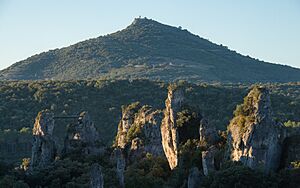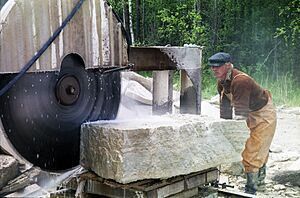Dolomite (rock) facts for kids
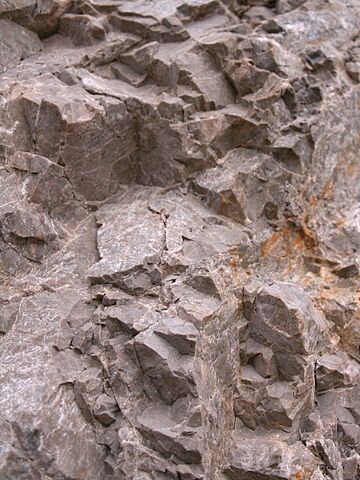
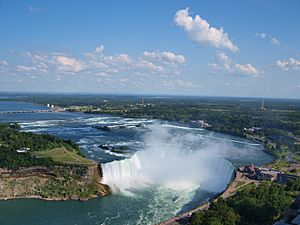
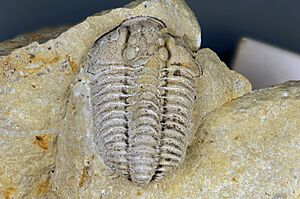
Dolomite is a type of sedimentary rock. It is mostly made of the mineral also called dolomite, which is a mix of calcium, magnesium, and carbonate. You can often find dolomite rock near limestone and other rocks formed from evaporated water. However, it's not as common as limestone.
A French geologist named Déodat Gratet de Dolomieu was one of the first to study and describe this rock in the late 1700s. He noticed it was different from limestone, and that's why it's named after him!
Most dolomite rock formed when magnesium-rich water changed existing limestone or lime mud. This process is called dolomitization. Scientists are still studying exactly how dolomite forms, especially why there's so much of it in ancient rocks but not much forming today. This puzzle is sometimes called the "dolomite problem."
Dolomite rock is quite strong and resists erosion. It can have layers or be solid. It doesn't dissolve as easily as limestone in slightly acidic water, but it can still form karst features like caves over a long time. If dolomite rock has enough tiny holes (porosity), it can even hold oil and natural gas.
Contents
What is Dolomite?
The name "dolomite" comes from Déodat Gratet de Dolomieu, a French expert in minerals and geology. He was born in 1750 and passed away in 1801. A Swiss chemist, Nicolas Théodore de Saussure, officially named the mineral after Dolomieu in 1792.
The word "dolomite" can refer to both the mineral itself and the rock that is mostly made of this mineral. To avoid confusion, some people use the term dolostone for the rock. However, many geologists still prefer to use "dolomite" for both.
How to Identify Dolomite Rock
Dolomite rock is a sedimentary rock that contains more than 50% of the mineral dolomite. This mineral has a special structure where magnesium and calcium are arranged in neat, alternating layers. This is different from limestone, where these elements are mixed more randomly.
In the field, geologists can recognize dolomite because it's not extremely hard. The mineral dolomite has a hardness of 4 or less on the Mohs scale. If you put a drop of weak hydrochloric acid on it, dolomite will bubble gently. Limestone, which is also soft, reacts much more strongly with the same acid.
Dolomite often has a dull yellow-brown color when it's exposed to the weather. This color comes from tiny bits of iron inside the rock. Dolomite usually looks like it's made of tiny sugar grains.
Under a microscope, dolomite grains often look like small, well-shaped diamonds (rhombs). These grains often have small spaces between them, making the rock porous. This porosity is why dolomite is important for storing oil and natural gas underground.
How Dolomite Forms
Dolomite is found all over the world, though it's not as common as limestone. It often appears alongside limestone or rocks formed from evaporated water. Most dolomite seems to have formed when sea levels were high. Not much dolomite is found in rocks younger than 65 million years old.
Many dolomite rocks show signs that they formed when magnesium replaced calcium in existing limestone. This process is called dolomitization. Scientists are still working to fully understand how this happens.
The process of dolomitization involves magnesium-rich fluids moving through limestone. Several ideas explain how this might happen:
- Hypersaline Model: In this idea, seawater in a closed basin evaporates a lot. This leaves behind a very salty, dense water (brine) that is rich in magnesium. This heavy brine then sinks into the limestone below, changing it into dolomite.
- Mixing-Zone Model: This idea suggests that fresh rainwater mixing with seawater underground can create the right conditions for dolomite to form.
- Seawater Model: Another idea is that regular seawater, moving through limestone due to tides or rising sea levels, can cause dolomitization.
Once dolomitization starts, it seems to happen quite quickly. It likely occurs at shallow depths where there's a constant supply of magnesium-rich seawater.
The Dolomite Problem
Even though dolomite should be able to form easily in seawater, scientists don't see it happening much in today's oceans. Also, it's very hard to create dolomite in labs at normal temperatures and pressures. This is the "dolomite problem."
One reason is that magnesium ions in water are surrounded by a strong "shell" of water molecules. It's difficult for these magnesium ions to break free and join a growing crystal. Calcium ions, which are larger, don't have this problem as much. Higher temperatures can help magnesium ions shed their water shells, which is why dolomite can form more easily in warmer conditions.
Some scientists think that tiny living things, like sulfate-reducing bacteria, might help dolomite crystals start to grow. These microorganisms could play a role in how dolomite formed in the past. Other research suggests that repeated cycles of water dissolving and then precipitating minerals might help dolomite crystals grow properly.
Dedolomitization
Sometimes, the process can reverse. Dolomite rock can change back into limestone. This usually happens when surface water, rich in calcium, seeps into the dolomite.
What is Dolomite Used For?
Dolomite is a very useful rock, similar to limestone, and is used in many ways:
- Construction: It's used as construction aggregate for roads and buildings.
- Agriculture: Farmers use it to make soil less acidic and to add important nutrients like calcium and magnesium.
- Industry: It's a source of carbon dioxide and is used as a filler in many products.
- Metallurgy: It helps in the process of making metals.
- Glass Manufacturing: Dolomite is an ingredient in making glass.
- Chemicals: It's used to produce magnesium chemicals, like Epsom salt, and as a magnesium supplement.
- Refractory Materials: It's used to make materials that can withstand very high temperatures.
Caves and Dolomite
Just like in limestone, natural caves can form in dolomite rock. This happens when weak acids, often from rainwater mixing with carbon dioxide, slowly dissolve the rock. Caves can also form, less commonly, from the dissolution of rock by sulfuric acid.
Inside these caves, you can find beautiful formations called speleothems, such as stalactites (hanging from the ceiling) and stalagmites (growing from the floor). These are usually made of calcite, even if the cave itself is in dolomite rock. While dolomite is a common rock, it's quite rare to find speleothems actually made of the dolomite mineral itself. When they do occur, they are usually in very small amounts and are very fine-grained.
See also
- Diagenesis


